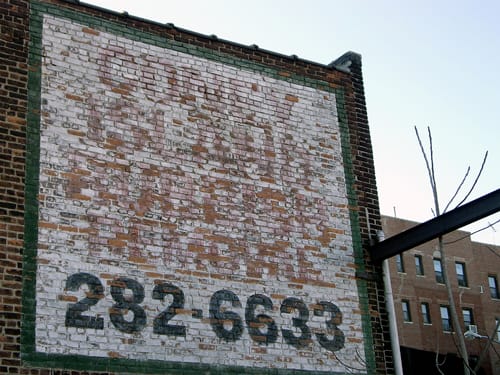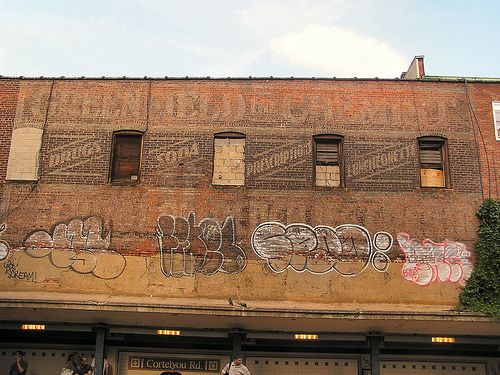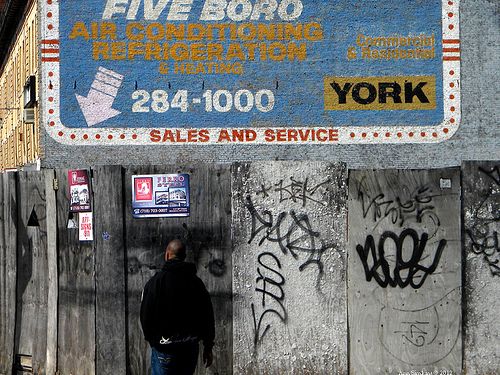Layers Upon Layers of New York’s Fading Ads


Frank Jump takes pictures of faded advertisements that recall an older New York. He’s taken simple pictures for a decade, providing an unparalleled connection to a century of history.
“I worked there,” wrote Tony in April 2009 when he saw the faded ad for Coney Island Rubbish Removal from the corner of Cortelyou Road and Coney Island Avenue (pictured above). “I drove roll from ‘75 to ‘86 with Studdering John, Fat Vinny, Dirty Ronnie. Anyone remember those guys?”
Two years later, as if out of the blue, Fat Vinny’s family found the picture, read Tony’s comment and answered that Vinny had died. Soon, Big Jim’s daughter delivered news of his death a decade ago. She hoped to talk to his own co-workers about his life.
The dead returned to life, even if very briefly, thanks to a Frank Jump’s picture of almost illegible chipped green paint in Ditmas Park.
Frank’s Fading Ad Blog started in 1999 as an all-HTML web site documenting a century’s worth of vintage mural ads on brickfaces in New York City. The vast collection of fading ads add up to a time machine that can bring you into close contact with the people and ideas of 20th century Gotham.
“I’m documenting a sign advertising a product that is no longer produced,” says Frank, “developed by a person no longer alive, painted by an ad company that is no longer in business.”
Beyond the peeling paint, there are layers upon layers of humanity, ideas and evidence to examine in fading ads.

How do ads fade?
New York’s walls are crowded. They’ve been notorious canvases for artists from around the world. When Frank or one of his readers finds an ad, he tries to establish its veracity.
What direction is the building facing? If an ad painted in blue has been exposed to direct sunlight for a century, it’ll be washed out almost completely.
“Blue and purple are unstable colors in paint,” says Frank, pointing out ads that seem ancient yet boast unbelievable blues in pictures from his impressive book. The ads are fake, he says, painted by a recent artist in homage or mimicry.

Photo: Clyde Adams III
Check the style. Does the ad font match the era it’s supposed to be from? Whether it’s the ad men of the 1910s or the Man Men of the 1960s, each era forged its own stylistic rules. In the same way that the Helvetica font may be associated with advertising in the 2000s, previous eras have their own preferred typefaces.
In a city that can change rather rapidly, development and demolition often means the loss of old ads.
“But it’s also a lot of fun,” says Frank, “because when one wall is torn down, it can uncover a lot of old ads seeing light for the first time in a long time.”
Frank has long expanded his project beyond the five boroughs to a global collection with contributors from around the world. Today, he employs a simple but effective strategy that has helped grow the collection to tens of thousands of pictures.
“Whenever we travel, we get a room in the seediest part of town,” said Jump to the Daily News. “Usually you find these ads in a part of town where they haven’t done any renovations yet.”
Fat Vinny and Studdering John moved trash at Coney Island Rubbish Removal 40 years ago. They’ve passed but their families have reconnected thanks to the ads that cling to life in these pictures. Family reunions have taken place thanks to the site, says Frank, and he’s become as close as family to people he’s met through his pictures.
There’s an entire study of genealogy that goes on around the site from the pictures to the comments section.
It goes without saying that Frank’s incredible work reveals a great deal about the past. Perhaps unintuitively, the pictures also reveal that ads, so often reviled as cold and inhumane, can shine a bright light on people who may otherwise have been forgotten.

Photo: Ann
Top photo: Frank Jump




